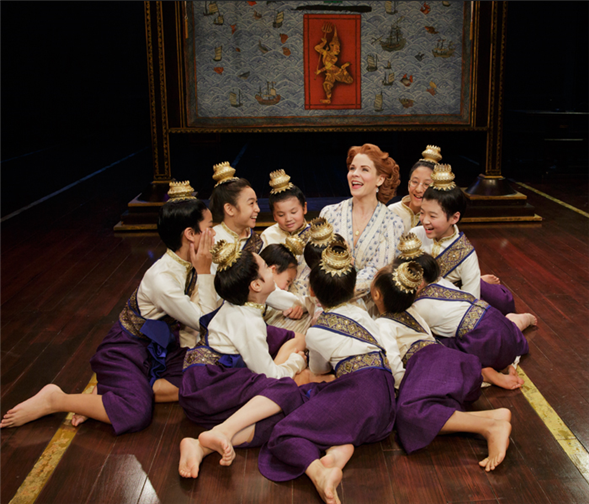Notes from the costume designer and wardrobe supervisor
---
Any parent – and anyone who has been parented in their lives – knows that keeping kids' clothes off the floor and free from stains is a full-time job.
Now picture more than a dozen children, each changing their (rather expensive) outfits every half hour for three hours straight.
This is the situation facing the dressers and other backstage crew members at
The King and I, the classic Rodgers and Hammerstein musical now being revived by Lincoln Center Theater. The show follows Anna Leonowens, a British teacher who unexpectedly finds herself educating the King of Siam's 11 children, which means the cast's youth ensemble is especially large. Add in the swing and the actor who plays Anna's young son, and you've got a baker's dozen of youngsters constantly looking for socks and frocks.
There are several grown-ups responsible for the kids' costumes, and needless to say, their lives are never dull.
"Not to be crude, but this is the age where boys start to smell like boys," says wardrobe supervisor Patrick Bevilacqua, who has worked with
King and I costume designer Catherine Zuber on more than a dozen shows.
A long run will also find boys – and girls – getting bigger, something that Zuber anticipated in her initial designs. "What we had to do was make their costumes more like jump suits," she says. "Kids usually grow up, not out, so we have some extra fabric in the waist area, underneath their cummerbunds."
Bevilacqua is in charge of the two dressers who get the young actors in and out of their clothes, and he's also the one who determines when that extra fabric is needed.
"At some point, there just won't be enough fabric to alter their clothes, and it will be time to recast the part," he says. (Zuber is more pointed on the topic: "If they get too tall, then it becomes casting's problem.") So the team tries to keep the children in the dark about these alterations. "We do them during the day, when they're not here," Bevilacqua says, "I've gotten good at casually saying, 'Hey, let me see that sleeve.'"
{Image1}
While researching Siam (now Thailand) in the 1860s, the time depicted in the musical, Zuber realized that the princes and princesses were dressed virtually identically until puberty. "You couldn't really tell the difference between the male children and female children," she says. "I thought at first that maybe the girls were somewhere else when these pictures were taken."
Once it became clear that both genders were present, Zuber did her own differentiation by color-coding the costumes – blues and purples for the boys, fuchsias and pinks for the girls – in a way that is more theatrically effective than historically accurate.
However, while both Zuber and Bevilacqua stress that this is an especially well-behaved group of children, one particular color has been popping up with dismaying regularity on male and female costumes alike. "A lot of kids have been losing their teeth," Bevilacqua says. "And as a result, blood is more of an issue than I'm used to. And it always seems to happen on their white costumes for the ['Small House of Uncle Thomas'] ballet."
Asked how he handles the dental issue, Bevilacqua quips, "We've been encouraging them to pull out their loose teeth at home."
---
Eric Grode is a freelance arts writer and a professor at Syracuse University's Goldring Arts Journalism Program
Photos by Paul Kolnik. Top photo: Kelli O'Hara as Anna, surrounded by young actors
